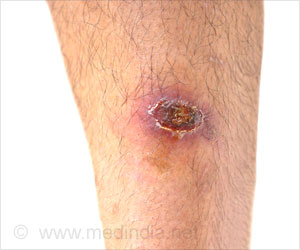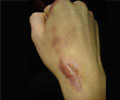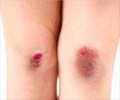A gel patch has been developed to speed up the healing of wounds and reduce scarring. This patch can benefit patients following surgery to reduce scar formation.
Highlights:
- A skin patch has been developed to improve wound healing and reduce scarring
- Angiopoietin-like 4 (ANGPTL4) is a protein that reduces inflammation, accelerates wound healing and reduces scarring
- Newly developed skin patch is enriched with ANGPTL4 that improves the process of wound healing and prevent scar formation
New Skin Patch for Wound Healing and Reduce Scarring
The research team led by Associate Professor Andrew Tan and Assistant Professor Cleo Choong found a protein that improves wound healing and reduces scarring.The research team already has a patent on the use of ANGPTL4 in wound healing. For the current study, the team developed the skin patch enriched with ANGPTL4 to reduce scarring.
“Scarring happens when excessive collagen produced by the body is assembled in one direction. To reduce scars, all we had to do was to find a 'tuning knob' that controls the amount of collagen produced, instead of turning it off completely which is what typical anti-scarring medicine does, and which could interfere with the healing process,” said Tan.
The team conducted experiments on mice with diabetic wounds. They found that wounds healed stronger and thrice faster with the application of ANGPTL4.
“The active ingredient ANGPTL4 can be harvested from discarded fatty tissues from patients in hospitals,” said Choong, a materials scientist at the School of Materials Science and Engineering
The scientists have also developed ways to use ANGPTL4 in different formulations such as gel patches, topical creams, and injectable microcapsules. “This will make it easy for doctors and even patients to use in future, should the product be made available to the market," said Choong.
How Does the Skin Patch work?
Commonly used anti-scarring medications target an "on-off switch" for collagen production, which is a pathway called TGFbeta-Smad3. When TGFbeta-Smad3 pathway is turned off, the production of collagen is stopped and scarring is prevented. But, when the collagen production is stopped, it affects wound repair, because collagen is needed for various processes in skin repair and regeneration.The research team found that ANGPTL4 can produce molecules that interfere with Scleraxis, thereby reducing the scar collagen production. ANGPTL4 could be useful in treating other fibrotic diseases such as keloids, which has no known treatment or prevention. A keloid is a raised scar that is larger than the wound that caused the scar.
Other research studies have also used ANGPTL4 protein from placenta and adipose (fat) tissue to accelerate healing in wounds. The NTU research team hopes to conduct further research to refine the gel formulation to improve its efficacy before conducting further lab experiments and eventually moving into clinical trials.
The findings of the study are published in Scientific Reports, a peer-reviewed journal of the Nature Publishing Group.
Reference:
- Ziqiang Teo, Jeremy Soon Kiat Chan, Han Chung Chong, Ming Keat Sng, Chee Chong Choo, Glendon Zhi Ming Phua, Daniel Jin Rong Teo, Pengcheng Zhu, Cleo Choong, Marcus Thien Chong Wong, Nguan Soon Tan. Angiopoietin-like 4 induces a β-catenin-mediated upregulation of ID3 in fibroblasts to reduce scar collagen expression. Scientific Reports, 2017; 7 (1) DOI: 10.1038/s41598-017-05869x
Source-Medindia













